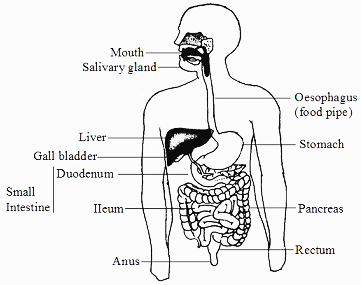Describe the alimentary canal of man.
Alimentary canal is also called as the digestive tract. It is the pathway by which food enters the body and solid wastes are expelled from the body. The human alimentary canal has the following main parts:
● Mouth: Alimentary canal starts from the mouth and ends in the anus. The mouth opens into a chamber or cavity called buckle cavity. The buckle cavity contains teeth, tongue and salivary glands. The teeth cut the food into small pieces, chew and grind it. The tongue has taste receptors which sense the taste of the food we eat. Salivary glands secrete (release) saliva which is mucus-like fluid, to help in swallowing the food.

● Oesophagus (food pipe): Buckle cavity opens into pharynx which leads to a long tube called oesophagus. It is present behind the windpipe (trachea) and heart, and in front of the spine. The walls are highly muscular. Digestion does not occur in the food pipe. When we swallow food, the walls of the oesophagus squeeze together (contract). It carries the food down into the stomach.
● Stomach: Stomach is a bag-like organ. It receives food from the food pipe. Highly muscular walls of the stomach help in churning the food. It secretes acids and enzymes that help in digesting the food.
● Small intestine: It is a highly coiled tube-like structure. The small intestine is longer than the large intestine but its lumen is smaller than that of the large intestine. The small intestine is divided into three parts, viz. duodenum, jejunum and ileum. In humans, the small intestine is the site of the complete digestion of food like carbohydrates, proteins, and fats. Its job is to absorb most of the nutrients from what we eat and drink.
● Large Intestine: Undigested food goes into the large intestine. Anus is the opening at the end of the alimentary canal through which undigested food is thrown out. It is the last part of the digestive system in vertebrates. Water is absorbed here and the remaining waste material is stored as feces before being removed by defecation.